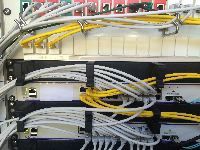How efficient are Swiss telecommunication networks compared with networks quoted in the international literature?
A BFE Study based on the Swiss upc cablecom network
In 2012 the communication networks, PCs and data centers are earch responsible for roughly 1.5% of the worldwide electricity consumption. How does a Swiss telecommunication network (cablecom) compare to similar networks in the world and how can it be made more efficient?

With the aid of life cycle assessment methods, a study published by the BFE evaluates the energy consumption as well as the physical infrastructure of the upc cablecom telecommunication network in Switzerland. Taking the years 2012 and 2013 as baseline, three different scenarios have been developed. These scenarios range from a network where best currently available technology at the location of the customers are assumed to a growth scenario where using the forecast of upc experts and assuming todays best availabel technologies.
The life cycle assessment has shown that the largest overall environmental impact is caused by equipment installed at the location of the users such as modems, complex set-top boxes and multimedia gateways as well as signal amplifiers. In contrast, the centralised services, such as data centres and transmitting infrastructure, only contribute a fourth or third of the total environmental impacts. This is due to the fact that CPEs are employed in large numbers. They also vary considerably in their energy demand as well as the ability to switch to energy saving modes when not being used. Centralised services as well as amplifiers have to be available all the time. As a telecommunication system is very hierarchical, centralised services are fewer in numbers and, hence, contribute less to the overall impact. The energy intensity of data transmission are very low compared with those mentioned in the relevant literature.
Future improvements can be achieved by employing the most efficient end user equipment and by avoiding multiple use of end user equipment. In the long term, the promotion of centralised services (cloud services) and exploiting the potential of smart electronics "beyond" end user equipment (such as modems and multimedia gateways) could decrease the energy demand of the telecommunication network.
Martin Streicher-Porte, Mischa Zschokke, Katja Pfeiffer,
Center for resource efficiency, Department of renewable energies and resource efficiency (IBRE), School of Engineering, University of Applied Sciences and Arts Northwestern Switzerland (FHNW)

